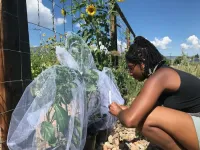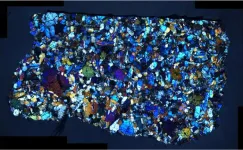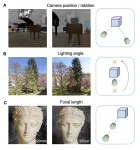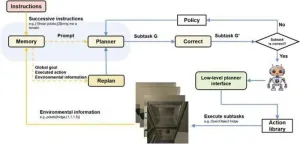(Press-News.org) Community gardens in higher-income Boulder neighborhoods have fewer varieties of bees than their medium-income counterparts, new University of Colorado Boulder research suggests. Scientists suggest that people in these neighborhoods tend to apply more landscaping practices, such as using fertilizers, which could impact bees’ habitats.
The finding appeared May 22 in the journal Urban Ecosystems.
“Bees are so important for local ecosystems through their pollination services. The landscape would not look the same without our pollinators,” said Asia Kaiser, a doctoral student in the Department of Ecology and Evolutionary Biology at CU Boulder.
The result came as a surprise to Kaiser and Julian Resasco, assistant professor in the Department of Ecology and Evolutionary Biology and the paper’s senior author, because it contradicted previous studies.
Prior research showed that wealthier urban neighborhoods tend to have more trees and green space. As a result, a greater diversity of animal species tends to live in these areas, a pattern called the luxury effect.
Ecologists Kaiser and Resasco wanted to explore how insects in urban gardens respond to the neighborhoods that surround them. Specifically, they are interested in how the urban environment could affect insects like bees that pollinate garden crops.
Last spring, the team planted about 70 jalapeño pepper plants in seven large community gardens across Boulder and Louisville. Using traps, the team collected more than 3,000 insects and other arthropods such as spiders from the gardens.
The researchers found that neighborhoods with more artificial structures—pavement, roads and rooftops that prevent water from soaking into the ground—had lower numbers of pollinators. At the same time, wealthier neighborhoods had fewer species of bees.
Landscaping practices and the type of plants that are more common in wealthier neighborhoods may contribute to lower bee biodiversity, Kaiser said. These communities tend to have more mature trees, which are different from plants found in native bees’ habitats. People living in these neighborhoods may also use more pesticides, fertilizers, water and mulch to support these plants, creating worse soil conditions for bees to nest in.
“Most of the bees found in these gardens, such as long-horn bees and squash bees, nest in the ground, so they are sensitive to changes in the soil,” Kaiser said.
In addition, the jalapeño pepper fruits grew larger in gardens with higher bee diversity, suggesting the important role that pollinators play in ecosystems.
Other arthropods—including pests like beetles and pest-eating predators like spiders—thrived in wealthier neighborhoods, the team found. It remains unclear why these critters were doing well, but Kaiser suspected they might be benefiting from the abundant food sources in the urban gardens.
the urban gardens may be providing sufficient food for them.
“It’s interesting that different animal groups are being impacted by different features of the urban environment,” Kaiser said.
She added that Colorado residents can plant more native plants and provide natural cover such as bare soil and downed wood for insects to nest in to promote bee diversity.
Next, the team plans to expand the experiments to community gardens in Denver. This will allow them to evaluate pollinator diversity in neighborhoods with a wider range of urbanization and socioeconomic status, including lower-income areas.
“Urban community gardens can be really important sources of nutrition in cities where nutritious food is often hard to come by,” Resasco said. “Understanding how different aspects of urbanization affect arthropod biodiversity and how that in turn affects the yield of these crops is very important.”
END
Wealthier neighborhoods in Boulder saw lower bee diversity
2024-05-31
ELSE PRESS RELEASES FROM THIS DATE:
Advancing excellence top priority for new board chair
2024-05-31
At its annual meeting on Thursday, the University of Miami Board of Trustees (BOT) confirmed Manuel “Manny” Kadre as its new chair, Wayne Chaplin and Bill Morrison as new vice chairs, and welcomed a slate of new trustees.
Kadre, chairman and chief executive officer of MBB Auto Group as well as a senior executive and shareholder of a number of beverage, automotive, health care, and real estate companies, first joined the board as a trustee in 2004. He served as a vice chair since June 2021 and more recently as board chair-elect.
“The University has one of the great reputations and brand names anywhere in the world,” ...
Martian meteorites deliver a trove of information on Red Planet’s structure
2024-05-31
Mars has a distinct structure in its mantle and crust with discernible reservoirs, and this is known thanks to meteorites that scientists at Scripps Institution of Oceanography at UC San Diego and colleagues have analyzed on Earth.
Meteorites that formed roughly 1.3 billion years ago and then ejected from Mars have been collected by scientists from sites in Antarctica and Africa in recent decades. Scripps Oceanography geologist James Day and his colleagues report May 31 in the journal Science Advances ...
Can ketones enhance cognitive function and protect brain networks?
2024-05-31
Researchers at the Del Monte Institute for Neuroscience at the University of Rochester have identified mechanisms in the brain’s hippocampal network that are rescued by ketones. These findings build on previous research showing that ketones can alleviate neurological and cognitive affects.
As we age our brain naturally becomes more insulin resistant. This creates a breakdown in communication between neurons, causing symptoms like changes in mood, cognitive decline, and eventually neurodegeneration. Nathan A. Smith, MS, PhD ('13), associate professor of Neuroscience, and fellow researchers studied the mechanisms in the brain that break down when insulin resistance is suddenly ...
AMS Science Preview: Sea-ice loss may accelerate; tornadoes and flying cars
2024-05-31
The American Meteorological Society continuously publishes research on climate, weather, and water in its 12 journals. Many of these articles are available for early online access–they are peer-reviewed, but not yet in their final published form.
Below is a selection of articles published early online recently. Some articles are open-access; to view others, members of the media can contact kpflaumer@ametsoc.org for press login credentials.
JOURNAL ARTICLES
Large-Scale Climate Modes Drive Low-Frequency Regional Arctic Sea Ice Variability
Journal of Climate
Arctic sea ice loss may accelerate in the coming decade. This study examined the dominant natural climate ...
UT Arlington, Microsoft host AI “Prompt-a-Thon”
2024-05-31
Faculty, staff and researchers from higher education and K-12 schools throughout Texas gathered in Arlington for the state’s first “Prompt-a-Thon” hosted by Microsoft and UTA’s offices of Research and Innovation and Information Technology. Together, educators and researchers learned how to best use artificial intelligence (AI) tools to improve their work.
“This Prompt-a-Thon is a significant step toward promoting AI literacy across multiple universities and establishing UTA as a frontrunner for AI use in the state,” said Jeremy Forsberg, associate ...
Children’s visual experience may hold key to better computer vision training
2024-05-31
UNIVERSITY PARK, Pa. — A novel, human-inspired approach to training artificial intelligence (AI) systems to identify objects and navigate their surroundings could set the stage for the development of more advanced AI systems to explore extreme environments or distant worlds, according to research from an interdisciplinary team at Penn State.
In the first two years of life, children experience a somewhat narrow set of objects and faces, but with many different viewpoints and under varying lighting conditions. Inspired by this developmental insight, the researchers introduced a new machine learning approach that uses information about spatial position to train AI visual ...
2024 Mahoney Life Sciences Prize goes to food scientist Lynne McLandsborough
2024-05-31
University of Massachusetts Amherst food scientist Lynne McLandsborough has won the 2024 Mahoney Life Sciences Prize for her research that offers a solution to a sticky sanitation and food safety dilemma hounding the peanut butter and chocolate industries.
“I was really surprised and excited,” McLandsborough says of winning the prize. “I think our research is innovative and there’s a need in the industry. It was a fun project.”
She is already in talks with Mars, the world’s ...
Ancient medicine blends with modern-day research in new tissue regeneration method
2024-05-31
For centuries, civilizations have used naturally occurring, inorganic materials for their perceived healing properties. Egyptians thought green copper ore helped eye inflammation, the Chinese used cinnabar for heartburn, and Native Americans used clay to reduce soreness and inflammation.
Flash forward to today, and researchers at Texas A&M University are still discovering ways that inorganic materials can be used for healing.
In two recently published articles, Dr. Akhilesh Gaharwar, a Tim and Amy Leach Endowed Professor in the Department of Biomedical Engineering, and Dr. Irtisha Singh, assistant professor in the Department of Cell Biology ...
Navigating new horizons: Pioneering AI framework enhances robot efficiency and planning
2024-05-31
In a groundbreaking study published in Cyborg Bionic Systems, researchers from Shanghai University have unveiled a new artificial intelligence framework that revolutionizes the way robots interpret and execute tasks. The "Correction and Planning with Memory Integration" (CPMI) framework leverages large language models (LLMs) to improve the efficiency and effectiveness of robots performing complex, instruction-based tasks.
Traditionally, robots required explicit programming and extensive data to navigate ...
Tirzepatide for weight reduction in Chinese adults with obesity
2024-05-31
About The Study: In Chinese adults with obesity or overweight, once-weekly injection with tirzepatide 10 mg or 15 mg resulted in statistically significant and clinically meaningful weight reduction with an acceptable safety profile.
Corresponding Author: To contact the corresponding author, Xiaoying Li, M.D., email li.xiaoying@zshospital.sh.cn.
To access the embargoed study: Visit our For The Media website at this link https://media.jamanetwork.com/
(doi:10.1001/jama.2024.9217)
Editor’s Note: Please see the article for additional information, including other authors, author contributions and affiliations, conflict of interest and financial ...








